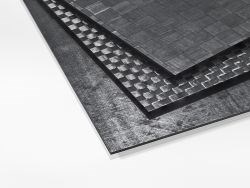SGL offers high-performance organosheet and thermoplastics for overmolding
“Thermoplastic toolbox” includes LFT, UD tapes, woven semi-finished sheets and carbon/glass hybrids in PA and polyolefins for automotive and other high-volume applications.
SGL Group (Wiesbaden, Germany) recently announced its launch of a thermoplastic materials toolbox, which will include long fiber thermoplastics (LFTs), unidirectional (UD) tapes, organosheets in polyamide (PA) and new developments regarding carbon fiber sized for polypropylene composites, thermoplastic profiles and carbon/glass hybrids for automotive and other high-volume applications.
Though this had been mentioned in their pre-JEC launch of a new lightweighting toolbox, featuring products based on rapid-curing epoxy, this latest release focuses squarely on thermoplastics. CW reached out to SGL for more details, and shares them here.
SGL started focused development for their thermoplastic offering in 2011, working with industry partners to build up new process chains and material concepts. Since 2015, it has offered a toolbox of materials based on large tow, 50K carbon fiber for polyamide (PA). More recent development includes new thermoplastic polymer profiles as well as carbon fibers suitable for polypropylene (PP) matrix systems.
SGL manufactures 50 K carbon fiber with thermoplastic sizing at its facilities in Moses Lake, WA, US and Muir of Ord, Scotland. For thermoplastic semi-finished materials, SGL developed pre-industrialized manufacturing lines in its Lightweight Application Center (LAC) in Meitingen (near Augsburg, Germany). In response to growing market demand, it has now developed industrialization concepts for scaling up this production.
SGL says it focuses on economic processes with good mechanical performance for high volume applications using 50K fibers. The sizing technology it has developed allows the use of any kind of polyamide. For its semi-finished product line, it offers one system in PA 6, is working on a system for PA 66 to be ready by the end of 2017, and is scheduled to release a system for PP to be released end of first quarter, 2018. For all of these systems, glass fibers with suitable sizing technologies are being offered as well.
SGL offers a variety of organosheet products based on carbon fiber (left) and glass fiber (right). SOURCE: SGL Group.
One-stop shop for optimized thermoplastic composites
SGL’s approach to the thermoplastic toolbox started with tapes and long fiber thermoplastic (LFT) in PA 6 to support the requirements of automotive manufacturing processes and end uses. It says polyamides are still favored by many automotive OEMs due to their superior mechanical and thermal performance compared to PP as well as a better cost position compared to high temperature polymer systems. Polypropylenes, on the other hand, have proven their suitability over the years in many automotive (and non-automotive) applications. Thus, SGL has decided to offer an additional product line for PP-based materials. It also sees a strong market trend toward the combination of glass fiber materials (to reduce cost and increase impact) with carbon fiber (for local reinforcement and load path optimized parts).
SOURCE: SGL Group.
SGL offers LFT materials for injection molding — which it says are especially suitable for large injection molded parts in demanding applications — and also in hybrid processes like organosheet thermoforming and overmolding. The company says its goal is to provide a one-stop-shop, where all materials within one matrix system can be combined with optimized compatibility. As all material systems are harmonized, there is reportedly no need for further qualification. With its well established 50K carbon fiber products and tailored manufacturing processes for semi-finished products in its thermoplastic toolbox, SGL says it provides the high-quality necessary for today’s manufacturing.
In its 1500-m2 Lightweight Application Center, SGL helps customers with simulation, process evaluation and material characterization to find optimized product and manufacturing options. The LAC offers both experienced engineers and versatile pilot lines as well as development of hybrid solutions by combining continuous semifinished materials with injection molding processes including processing via tape placement, thermoforming and automated handling.
For more information on thermoplastic composite overmolding:
3D TPC structural preforming process lightens car doors in volume process
Injection overmolded composites demo comes to conclusion
RocTool composite demo at K 2016
CAMISMA’s car seat back: Hybrid composite for high volume
 |
 |
Related Content
Materials & Processes: Resin matrices for composites
The matrix binds the fiber reinforcement, gives the composite component its shape and determines its surface quality. A composite matrix may be a polymer, ceramic, metal or carbon. Here’s a guide to selection.
Read MoreCryo-compressed hydrogen, the best solution for storage and refueling stations?
Cryomotive’s CRYOGAS solution claims the highest storage density, lowest refueling cost and widest operating range without H2 losses while using one-fifth the carbon fiber required in compressed gas tanks.
Read MoreThermoplastic composites welding advances for more sustainable airframes
Multiple demonstrators help various welding technologies approach TRL 6 in the quest for lighter weight, lower cost.
Read MoreMaterials & Processes: Fibers for composites
The structural properties of composite materials are derived primarily from the fiber reinforcement. Fiber types, their manufacture, their uses and the end-market applications in which they find most use are described.
Read MoreRead Next
From the CW Archives: The tale of the thermoplastic cryotank
In 2006, guest columnist Bob Hartunian related the story of his efforts two decades prior, while at McDonnell Douglas, to develop a thermoplastic composite crytank for hydrogen storage. He learned a lot of lessons.
Read MoreCW’s 2024 Top Shops survey offers new approach to benchmarking
Respondents that complete the survey by April 30, 2024, have the chance to be recognized as an honoree.
Read MoreComposites end markets: Energy (2024)
Composites are used widely in oil/gas, wind and other renewable energy applications. Despite market challenges, growth potential and innovation for composites continue.
Read More


















.jpg;maxWidth=300;quality=90)










